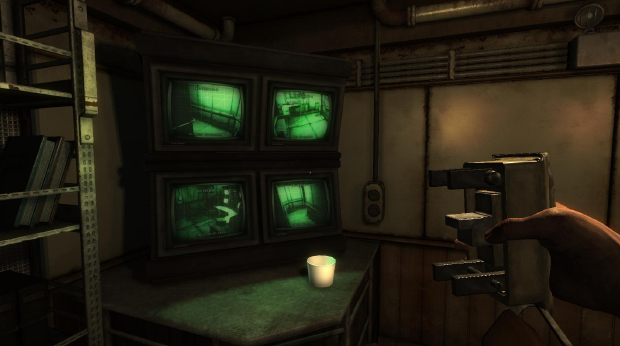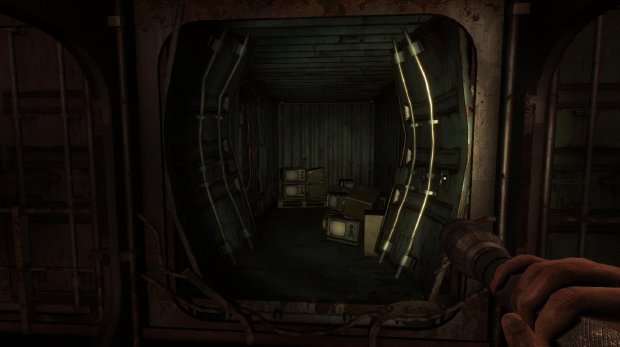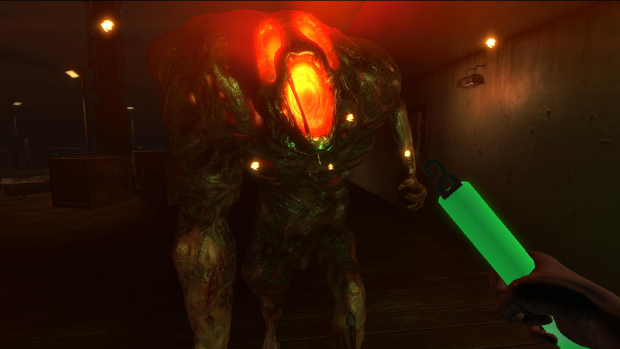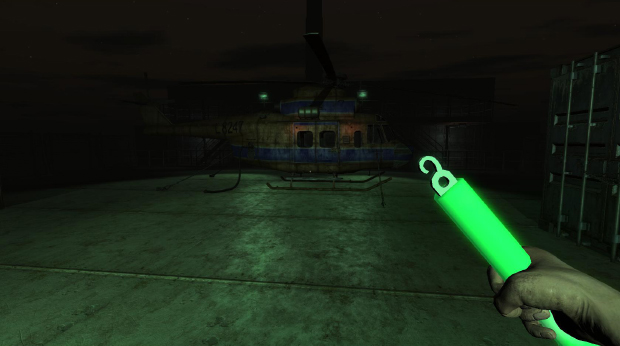Premature Evaluation: Monstrum
Dead in the Water
Each week Marsh Davies skittishly edges into the gloomy bowels of Early Access and comes back with any stories he can find and/or simply hides in a locker and tries not to cry too loudly. This week he dons his brownest trousers and hopes never to face his fears in Monstrum, a firstperson horror game set on a boat that procedurally reconfigures its layout every time you get eaten.
My, hasn’t the Find Some Things While Being Chased By A Thing genre come a long way? Only two and half years ago it was largely consigned to the realms of shonky boo-scare creepypasta homage. Now we have dozens upon dozens of iteratively-improved indie imitators, and even the lustrously-rendered likes of Alien: Isolation, which took Slender’s sandbox-scare principles to the triple-A firmament. You’d think, after all the shrieky reaction-cams, exhaustively explored lockers and soiled pants, that a new entrant of this genre would have to try ever so hard to be as effective - and, to its credit, Monstrum does give an earnest shake to the basics, inasmuch as the procedurally arranged cabins and corridors give its replays a Roguish unpredictability. But, largely, this is a retreat from the fulsome narrative structures of Alien or Outlast to something more simple and, ahem, slender: a gloomy environment and stuff to find in it, before something finds you and permadeaths you through the brain.
Awaking with amnesia, the protagonist’s perennial curse, you must scavenge a few erratically punctuated journal entries to make sense of your predicament. Apparently, you’ve been a bit poorly and, during your convalescence, something ate a lot of the crew. Those that remained skedaddled to a life raft, leaving you only an apologetic note and a few overturned lockers to barricade your cabin. It’s probably obvious that you should think of escaping too, by one of several routes: life-raft, helicopter or submersible, and possibly others I have not yet discovered. Which you should choose depends on your luck at recovering various items, secreted in different locations on each playthrough. An aerial exfiltration will demand bolt cutters, keys and the helpfully described “nearby equipment”, which, in my experience, is not actually nearby. The submersible requires new lights, a welding kit, a battery, and balls of steel while you wait out the extremely noisy launch sequence. I haven’t yet succeeded in escaping even once.
You can only carry five items at a time, and you might want to save a few slots for glowsticks, noisemakers, fire extinguishers and other handy tools - so you can’t really hedge your bets over which route you’ll take. You need to go for one, and stick to it. Although, you won’t really have a sense for which one is the more viable on any given playthrough until you’ve died a large number of times - what items are needed, what they look like, where you are likely to find them and how you use them is not something that you’ll ever intuit first time round. Your surroundings are similarly unfamiliar: even without the ship switching its corridors about, it remains a maze of twisting, darkened halls and identical rusting bulkheads that resists your ability to memorise. I think a fair amount could be done to make things a bit less baffling - at least to get you up to speed with your protagonist’s presumed knowledge of ship procedure - but clearly the idea is that you aggregate the knowledge required for survival over successive lives.
And you’ll certainly go through plenty of those. Even without a bogeyman on the loose, Monstrum’s ship is a safety compliance officer’s nightmare, with deadly drops and ruptured pipes that periodically emit lethal jets of steam. Dying to these is instant and really quite irritating: your mind is on bigger things and then - squirt! - game over. You can disable them with nearby valves, but this feels a bit of a chore. I can see why they were thought to be a good idea: taking control of your environment is good preparation for later, when you may need to book it down this same hall with something in hot pursuit. And yet, to stumble from a gloomy galley into Videogames Deathtrap Corridor feels a weirdly obtrusive contrivance.
You really do have bigger problems, too: something hunts you in the darkness of this derelict ship - exactly what, and how, changes. Monstrum’s big draw is that it will eventually have a bestiary of three possible foes and you never know which you’ll face on a given attempt. The variety in this early alpha is limited to just two flavours of horrible, and I’ll only talk about one of them: a hulking, glowing brute that has already appeared in the promotional material for the game. You can hear it thumping down the corridors, its fiery glow giving you small forewarning of its appearance round corners. Despite some time with the game, I haven’t been able to discern its rationale or process for finding you - although it often does, pounding across the space between you to snap your neck. Hiding in lockers, the number one pastime of gaming protagonists in 2014, seems only occasionally effective, though I’m not sure why. You also have noisemakers and throwable items, but I’ve not been able to make effective use of them: the ship’s unknowable layout rarely allows you deploy such lures with forethought, and the cramped confines often mean you face the monster down a narrow corridor. Throwing a coffee cup to distract it is not going to work - although I have tried.
Other monsters may have alternative ways of traversing the ship and, supposedly, other means by which they detect the player’s presence. I don’t know what they are, because, as with Alien, a lot of the AI smarts is sadly but unavoidably invisible to the player. I think these games would be a lot more interesting to me, although a lot less scary, if you had a top down view, and could see the monster AI at work, snuffling round bulkheads and poking about in lockers, declaring its every thought or suspicion. As it is, the intelligence against which you pit your own wits is reduced to a lethal cameo: either it’s here, and you’re dead, or it’s somewhere else.
That said, I appreciate that the Find Some Things While Being Chased By A Thing genre is an attempt to systematise horror, to try and make it true to the medium of games rather than simply ape cinema. The experience of playing a game can never be anything like the experience a horror film protagonist has in his or her linear narrative; the foreknowledge and repetition make horror games a structurally and emotionally distinct experience. Monstrum’s reconfiguring corridors and alternating antagonists address the problems of over-familiarising yourself with the threat through multiple playthroughs, even if it sacrifices some of its coherency as a setting to do so.
It’s certainly basically effective: as you scuttle around the decaying and deserted hulk, jumping at every rattle and creak, Monstrum proves that the bare bones of the genre are themselves unnerving. That said, if you put me in a dark box and occasionally make a loud banging noise, you can pretty much consistently trigger my fight-or-flight response (though mostly just flight). With that in mind, I’m not sure it’s enough, for me personally, to be scared - I also have to be interested as well, and I worry that the task of collecting items feels too unknowable, repetitive and arbitrary. My excitement hinges on the potential of Monstrum’s AI encounters: how visibly you can interact with it; how distinct in its behaviour one monster is from another. The other bugbears with the alpha - clunky menus, botched animations, absent “save and quit” features and keybindings dredged from the very depths of hell itself - I have confidence these will be addressed. But my personal qualms are broader: the genre’s come along way since Slender, I just don’t know if it's in a direction I'm particularly keen to follow.
Monstrum is available from Steam for £10, and it’s planned to stay in Early Access for 3-5 months before launching at a full price of £12. I played version 0.8.2 on 12/02/2015.






